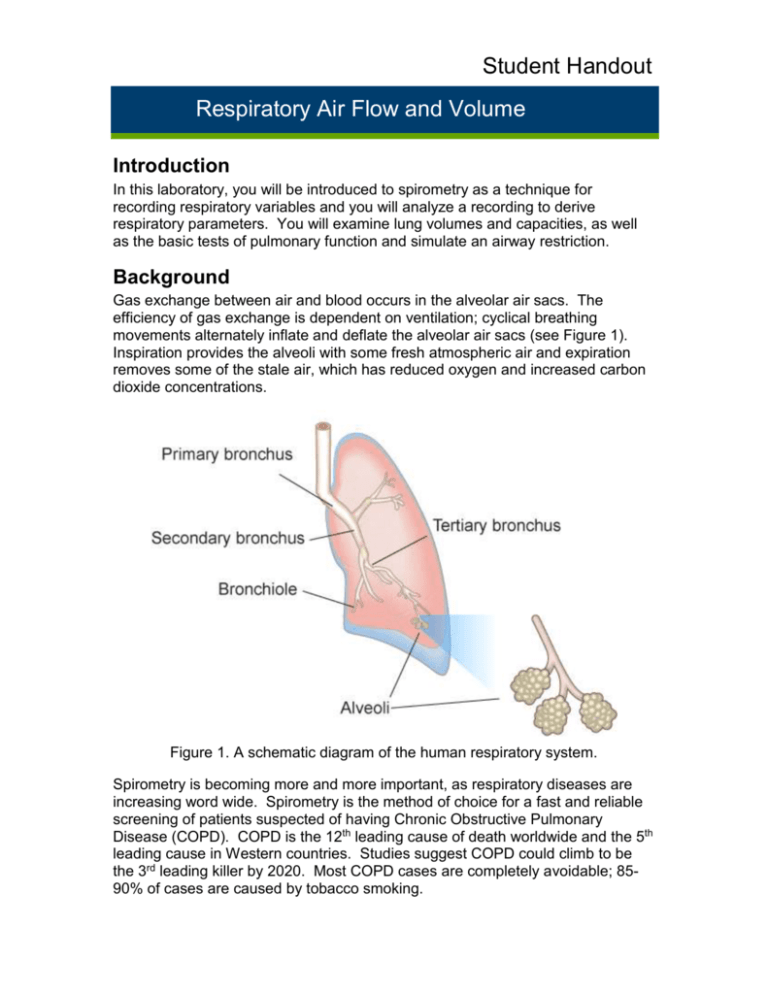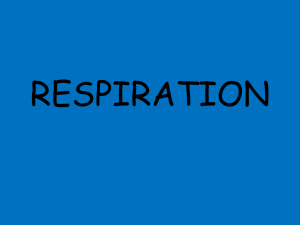Air Flow and Volume Student Handout
advertisement

Student Handout Respiratory Air Flow and Volume Introduction In this laboratory, you will be introduced to spirometry as a technique for recording respiratory variables and you will analyze a recording to derive respiratory parameters. You will examine lung volumes and capacities, as well as the basic tests of pulmonary function and simulate an airway restriction. Background Gas exchange between air and blood occurs in the alveolar air sacs. The efficiency of gas exchange is dependent on ventilation; cyclical breathing movements alternately inflate and deflate the alveolar air sacs (see Figure 1). Inspiration provides the alveoli with some fresh atmospheric air and expiration removes some of the stale air, which has reduced oxygen and increased carbon dioxide concentrations. Figure 1. A schematic diagram of the human respiratory system. Spirometry is becoming more and more important, as respiratory diseases are increasing word wide. Spirometry is the method of choice for a fast and reliable screening of patients suspected of having Chronic Obstructive Pulmonary Disease (COPD). COPD is the 12th leading cause of death worldwide and the 5th leading cause in Western countries. Studies suggest COPD could climb to be the 3rd leading killer by 2020. Most COPD cases are completely avoidable; 8590% of cases are caused by tobacco smoking. Student Handout Respiratory Air Flow and Volume Many important aspects of lung function can be determined by measuring airflow and the corresponding changes in lung volume. In the past, this was commonly done by breathing into a bell spirometer, in which the level of a floating bell tank gave a measure of changes in lung volume. Flow, F, was then calculated from the slope (rate of change) of the volume, V: F = dV dt Equation 1 More conveniently, airflow can be measured directly with a pneumotachometer (from Greek roots meaning “breath speed measuring device”). The PowerLab pneumotachometer arrangement is shown in Figure 2. Figure 2. The PowerLab pneumotachometer. Several types of flow measuring devices are available and each type has advantages and disadvantages. The flow head you will use today is a “Lilly” type that measures the difference in pressure either side of a mesh membrane with known resistance. This resistance gives rise to a small pressure difference proportional to flow rate. Two small plastic tubes transmit this pressure difference to the Spirometer Pod, where a transducer converts the pressure signal into a changing voltage that is recorded by the PowerLab and displayed in LabTutor. The volume, V, is then calculated as the integral of flow: V= F dt Equation 2 Student Handout Respiratory Air Flow and Volume This integration represents a summation over time; the volume traces that you will see in LabTutor during the experiment are obtained by adding successive sampled values of the flow signal and scaling the sum appropriately. The integral is initialized to zero every time a recording is started. A complication in the volume measurement is caused by the difference in air temperature between the Spirometer Pod (at ambient temperature) and the air exhaled from the lungs (at body temperature). The volume of gas expands with warming, therefore the air volume expired from the lungs will be slightly greater than that inspired. Thus a volume trace, as calculated by integration of flow, drifts in the expiratory direction. To reduce the drift, the flow has to be integrated separately during inspiration and expiration, with the inspiratory volume being corrected by a factor related to the BTPS factor (body temperature, atmospheric pressure, saturated with water vapor). The LabTutor software makes this correction. Spirometry allows many components of pulmonary function (see Figure 3 below) to be visualized, measured and calculated. Respiration consists of repeated cycles of inspiration followed by expiration. During the respiratory cycle, a specific volume of air is drawn into and then expired from the lungs; this volume is the Tidal Volume (VT). In normal ventilation, the breathing frequency (ƒ) is approximately 15 respiratory cycles per minute. This value varies with the level of activity. The product of ƒ and VT is the Expired Minute Volume ( VE ), the amount of air exhaled in one minute of breathing. This parameter also changes according to the level of activity. Note that the volume of air remaining in the lungs after a full expiration, residual volume (RV), cannot be measured by spirometry as a volunteer is unable to exhale any further. Student Handout Respiratory Air Flow and Volume Figure 3. Lung volumes and capacities. Terms that you should be familiar with before coming to class. Term Respiratory Rate Expired Minute Volume Abbreviation / Symbol RR Units VE RR x VT breaths / min (BPM) L/min VT IRV ERV RV (predicted) L L L L IC = VT + IRV EC = VT + ERV VC = IRV + ERV + VT FRC = ERV + RV TLC = VC + RV L L L L L PIF PEF FVC FEV1 FEV1/FVC x 100 L/min L/min L L Lung Volumes Tidal Volume Inspiratory Reserve Volume Expiratory Reserve Volume Residual Volume Lung Capacities Inspiratory Capacity Expiratory Capacity Vital Capacity Functional Residual Capacity Total Lung Capacity Pulmonary function tests Peak Inspiratory Flow Peak Expiratory Flow Forced Vital Capacity Forced Expired Volume in one second % FVC expired in one second Student Handout Respiratory Air Flow and Volume What you will do in the laboratory There are five exercises that you will complete during this Lab. 1. Becoming familiar with the equipment. In this exercise, you will learn the principles of spirometry, and how integration of the flow signal gives a volume. 2. Lung volumes and capacities. Here you will examine the respiratory cycle and measure changes in flow and volume. 3. Pulmonary function tests. Here you will measure parameters of forced expiration that are used in evaluating pulmonary function. 4. Simulating an airway restriction. In this exercise, you will simulate an airway restriction. 5. Variability amongst group members. In this exercise, you will compare the parameters of forced expiration measured in different students.











